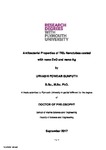Antibacterial Properties of TiO2 Nanotubes coated with nano-ZnO and nano-Ag
| dc.contributor.supervisor | Li, Long-yuan | |
| dc.contributor.author | Gunputh, Urvashi Fowdar | |
| dc.contributor.other | School of Biological and Marine Sciences | en_US |
| dc.date.accessioned | 2018-03-22T11:59:34Z | |
| dc.date.issued | 2018 | |
| dc.date.issued | 2018 | |
| dc.identifier | 10460957 | en_US |
| dc.identifier.uri | http://hdl.handle.net/10026.1/11155 | |
| dc.description | Chapter 2: Published in ECS journal _ Modified Chapter 3: Manuscript with Materials Science & Engineering C | en_US |
| dc.description.abstract |
TiO2 nanotubes grown on titanium alloy are known to increase the biocompatibility of the alloy when used in dental/orthopaedic implants. Furthermore, their nanotubular structures can act as antibacterial agent carrier and as a scaffold for tissue engineering with the aim of adding antibacterial properties to the implant. This study aims at fabricating an antibacterial and biocompatible nanocomposite coating on Ti-6Al-4V involving nano-ZnO and nano-Ag. Initially, TiO2 nanotubes were self-assembled on the polished surface of medical grade Ti-6Al-4V alloy discs using anodisation. First silver nanoparticles were chemically reduced from silver ammonia using delta-δ-gluconolactone for different duration on the nanotubes to form TiO2-Ag composite coating. Nano HA was added to the latter coating with the aim of reducing toxicity from silver, hence forming TiO2-Ag-HA coating. Secondly, nano-ZnO was thermo-chemically grown on the TiO2 nanotubes using zinc nitrate and hexamethylenetetramine. They were then annealed at 350-550 ºC hence forming TiO2-ZnO. HA was grown on the latter coating by a biomimetic method whereby the coated discs were placed in a concentrated simulated body fluid at 37 ºC forming TiO2-ZnO-HA. The stability of the 4 coatings, TiO2-Ag, TiO2-Ag-HA, TiO2-ZnO and TiO2-ZnO-HA were assessed using the dialysis method (n=3 each) and then exposed to S.aureus for 24 hours in BHI broth. Their antibacterial properties were assessed using different assays and microscopic imaging with respect to different controls (n=6 each for assays and n=3 for imaging). Their biocompatibility properties were assessed in the presence of primary human osteoblast cells in DMEM media with the help of biochemical assays, molecular gene expression and microscopic imaging (n=3). Both silver and zinc coated nanotubes showed significant level of antibacterial properties with silver coating being more bactericidal than the coating containing zinc. Nonetheless, the zinc oxide coatings were more biocompatible than the silver coating. Nano silver and zinc oxide containing composite coatings were successfully synthesised and tested in the presence of bacteria and human cells. The final conclusion was that nano-silver was still toxic and nano-ZnO coatings were more biocompatible. | en_US |
| dc.language.iso | en | |
| dc.publisher | University of Plymouth | |
| dc.rights | Attribution-NonCommercial 3.0 United States | * |
| dc.rights.uri | http://creativecommons.org/licenses/by-nc/3.0/us/ | * |
| dc.subject | Nanoparticles | |
| dc.subject | Anodisation | |
| dc.subject | Antibacterial | |
| dc.subject | Biocompatibility | |
| dc.subject | Comparative Ct | |
| dc.subject | PCR | |
| dc.subject | Toxicity | |
| dc.subject | Osteoblast cells | |
| dc.subject | Staphylococcus aureus | |
| dc.subject | Nanotubes | en_US |
| dc.subject.classification | PhD | en_US |
| dc.title | Antibacterial Properties of TiO2 Nanotubes coated with nano-ZnO and nano-Ag | en_US |
| dc.type | Thesis | |
| plymouth.version | publishable | en_US |
| dc.identifier.doi | http://dx.doi.org/10.24382/1008 | |
| dc.rights.embargodate | 2019-03-22T00:00:00Z | |
| dc.rights.embargoperiod | 12 months | en_US |
| dc.type.qualification | Doctorate | en_US |
| rioxxterms.funder | Plymouth University | en_US |
| rioxxterms.identifier.project | Biointeractions of Self-assembled TiO2 Nanotubes Grown on Titanium Alloy Medical Implants | en_US |
| rioxxterms.version | NA | |
| plymouth.orcid.id | https://orcid.org/0000-0002-8739-2427 | en_US |
Files in this item
This item appears in the following Collection(s)
-
01 Research Theses Main Collection
Research Theses Main



